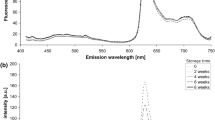Abstract
The production of cold-pressed oil from nonroasted naked pumpkin seeds by pressing with screw presses started in the Republic of Serbia at the end of 1990s. This oil has the characteristic flavour of raw-dried seeds, and is a specific product of this region. The oil samples were prepared by pressing naked pumpkin seeds and pumpkin seeds with the hulls in a 3:2 ratio using a screw press. The changes of the oil sensory characteristics, basic chemical quality and oxidative stability were followed over a 2-year period. The results obtained showed that the oil sensory quality was stable during the first 12 months of storage, after which the flavour became musty. Although the chemical quality of the oil deteriorated to some extent, both the acid and peroxide values satisfied the legislative minimum during the whole investigation time. The oxidative stability of oil determined by a Rancimat apparatus was good, although the induction period after 2 years decreased by 25–40%. To ensure the use of only the highest quality oil, a 12-month shelf life is recommended.


Similar content being viewed by others
References
Dimic E (2005) Cold-pressed oils, monograph. University of Novi Sad, Faculty of Technology, Novi Sad, (Serbia)
Matthäus B, Spener F (2008) What we know and what we should know about virgin oils—a general introduction. Eur J Lipid Sci Technol 110:597–601
Raβ M, Schein C, Matthäus B (2008) Virgin sunflower oil. Eur J Lipid Sci Technol 110:618–624
Fruhwirth GO, Hermetter A (2008) Production technology and characteristics of Styrian pumpkin seed oil. Eur J Lipid Sci Technol 110:637–644
Yu L, Parry JW, Zhou K (2005) Oils from herbs, spices and fruit seeds. In: Shahidi F (ed) Bailey’s industrial oil and fat products, vol 3, 6th edn. Wiley, USA, pp 250–252
Kreft S, Kreft M (2007) Physicochemical and physiological basis of dichromatic colour. Naturwissenschaften 94:935–939
Turkulov J, Karlovic DJ, Dimic E, Pribis V (1983) Oil colour determination by the tristimulus colorimeter. J Edible Oil Ind 20(2):85–91
Vuksa V, Dimic E, Dimic V (2003) Characteristics of cold-pressed pumpkin seed oil. 9th symposium: vitamins and additives in nutrition of man and animal, proceedings, Jena/Thüringen (Germany), pp 493–496
Dimic E, Dimic V, Romanic R (2003) Process and quality of expeller oil obtained from pumpkin seed. J Oil Soap Cosmet 70(3):93–96
Joint FAO/WHO Food Standards Programme, Codex standards for named vegetable oils, Codex-STAN 210, Amended 2005
Rac M (1964) Oils and fats. Business Association of Production and Processing of Oilseeds, Beograd, (Serbia)
Fruhwirth GO, Hermetter A (2007) Seeds and oil of the styrian oil pumpkin: components and biological activities. Eur J Lipid Sci Technol 109:1128–1140
Murkovic M, Pfannhauser W (2000) Stability of pumpkin seed oil. Eur J Lipid Sci Technol 102:607–611
Dimic E, Turkulov J (2000) Quality control in edible oil technology, University of Novi Sad, Faculty of Technology, Novi Sad (Serbia), pp 125–130, 151–153
Matsui T, Guth H, Grosch W (1998) A comparative study of potent odorants in peanut, hazelnut, and pumpkin seed oils on the basis of aroma extract dilution analysis (AEDA) and gas chromatography olfactometry of headspace samples (GCOH). Fett Lipid 100:51–56
Shimoda M, Nakada Y, Nakashima M, Osajima Y (1997) Quantitative comparison of volatile flavor compounds in deep-roasted and light-roasted sesame seed oil. J Agric Food Chem 45:3193–3196
Siegmund B, Murkovic M (2004) Changes in chemical composition of pumpkin seeds during the roasting process for production of pumpkin seed oil (part 2: volatile compounds). Food Chem 84:367–374
Haiyan Z, Bedgood DR Jr, Bishop AG, Prenzler PD, Robards K (2007) Endogenous biophenol, fatty acid and volatile profiles of selected oils. Food Chem 100:1544–1551
Al-Khalifa AS (1996) Physicochemical characteristics, fatty acid composition, and lipoxygenase activity of crude pumpkin and melon seed oils. J Agric Food Chem 44:964–966
Dimic E, Romanic R, Vujasinovic V (2008) Influence of roasting on oxidative stability of naked Olinka variety pumpkin seed oil. Breeding 08-international conference “Conventional and molecular breeding of field and vegetable crops”, conference proceedings, pp 521–524, Institute of Field and Vegetable Crops, Novi Sad (Serbia)
The European Commission (2007) Protected geographical indication; “Steirisches Kürbiskernöl”. http://ec.europa.eu/agriculture/qual/en/au_en.htm Dossier number: AT/PGI/0017/1460
Parry J, Hao Z, Luther M, Su L, Zhou K, Yu L (2006) Characterization of cold-pressed onion, parsley, cardamom, mullein, roasted pumpkin and milk thistle seed oils. J Am Oil Chem Soc 83:847–854
Younis YMH, Ghirmay S, Al-Shihry SS (2000) African Cucurbita pepo L.: properties of seed and variability in fatty acid composition of seed oil. Phytochemistry 54:71–75
Neđeral Nakic S, Rade D, Skevin D, Strucelj D, Mokrovcak Z, Bartolic M (2006) Chemical characteristics of oils from naked and husk seeds of Cucurbita pepo L. Eur J Lipid Sci Technol 108:936–943
Elmadfa I, Wagner KH (1997) Vitamin E und Haltbarkeit von Pflanzenölen. Fett/Lipid 99:234–238
Tuberoso CIG, Kowalczyk A, Sarritzu E, Cabras P (2007) Determination of antioxidant compounds and antioxidant activity in commercial oilseeds for food use. Food Chem 103:1494–1501
Fruhwirth GO, Wenzl T, El-Toukhy R, Wagner FS, Hermetter A (2003) Fluorescence screening of antioxidant capacity in pumpkin seed oil and other natural oils. Eur J Lipid Sci Technol 105:266–274
Andjelkovic M, Van Camp J, Trawka A, Verhé R (2010) Phenolic compounds and some quality parameters of pumpkin seed oil. Eur J Lipid Sci Technol 112:208–217
Acknowledgments
The authors acknowledge the financial support of the Ministry of Science and Technological Development of the Republic of Serbia (Project: MNTR 20089).
Author information
Authors and Affiliations
Corresponding author
About this article
Cite this article
Vujasinovic, V., Djilas, S., Dimic, E. et al. Shelf Life of Cold-Pressed Pumpkin (Cucurbita pepo L.) Seed Oil Obtained with a Screw Press. J Am Oil Chem Soc 87, 1497–1505 (2010). https://doi.org/10.1007/s11746-010-1630-x
Received:
Revised:
Accepted:
Published:
Issue Date:
DOI: https://doi.org/10.1007/s11746-010-1630-x




